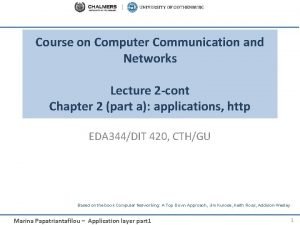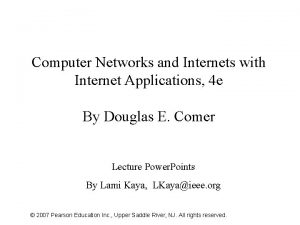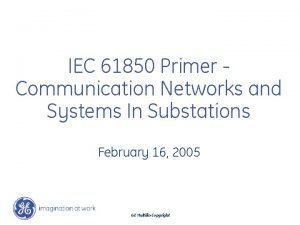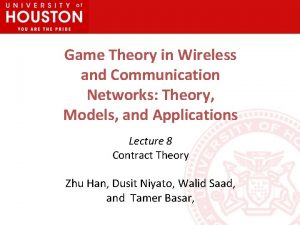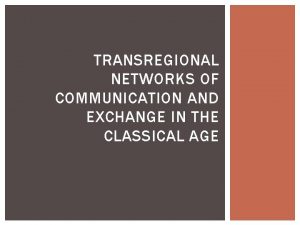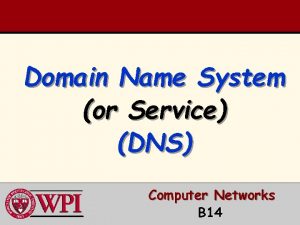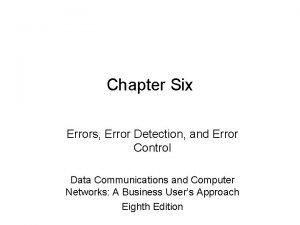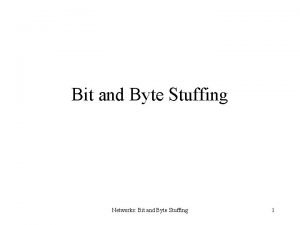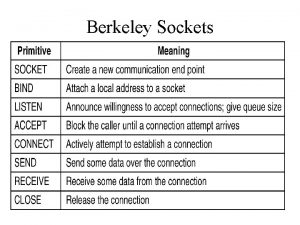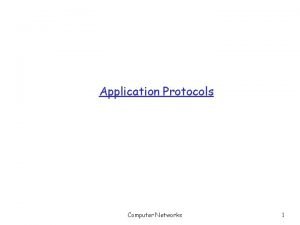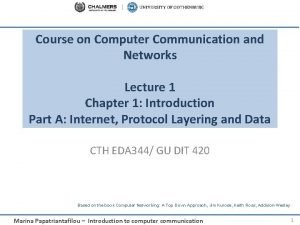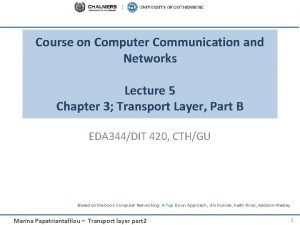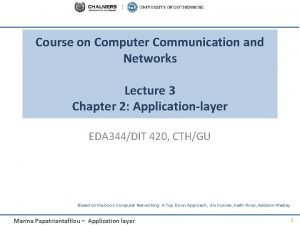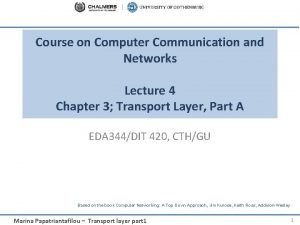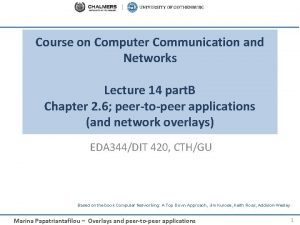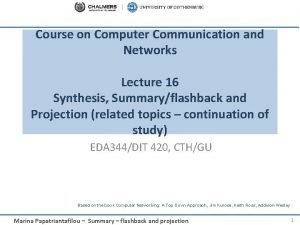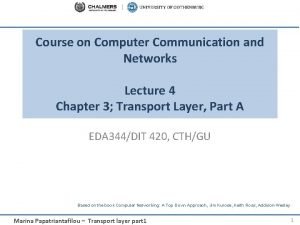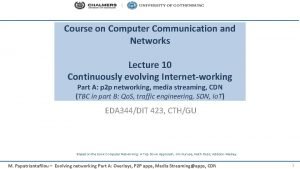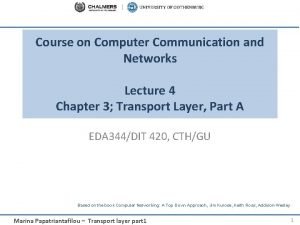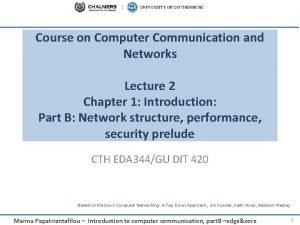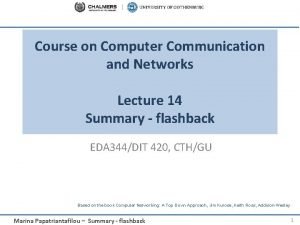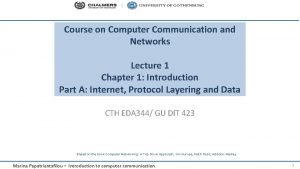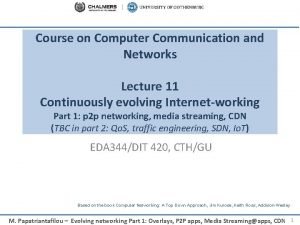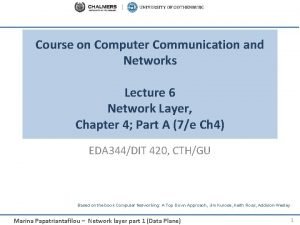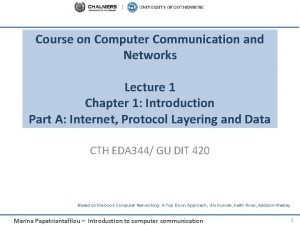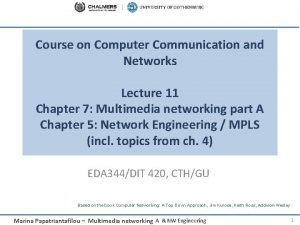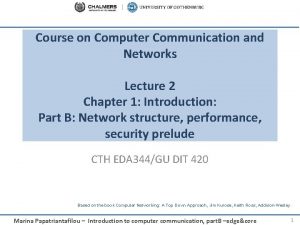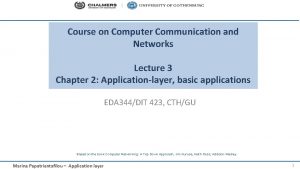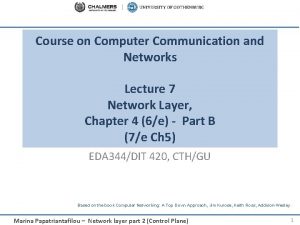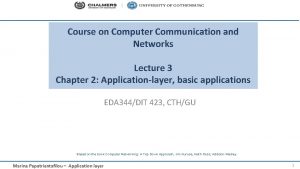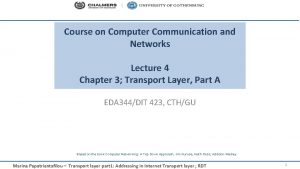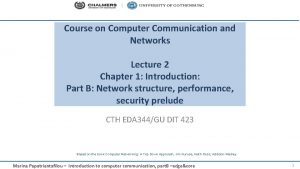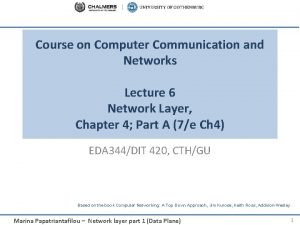Course on Computer Communication and Networks Lecture 15



















































- Slides: 51

Course on Computer Communication and Networks Lecture 15 Summary (flashback) and Projection (related topics – continuation of study) EDA 344/DIT 420, CTH/GU Based on the book Computer Networking: A Top Down Approach, Jim Kurose, Keith Ross, Addison-Wesley. Marina Papatriantafilou – Summary - flashback 1

Important for the exam When/where: wednesday March 16, 14. 00 -18. 00, M-building You may have with you: • English-X dictionary • no calculators, PDAs, etc (if/where numbers matter, do rounding) Grading • 30 -40, 41 -50, 51 -60 (out of 60)= 3, 4, 5 (CTH) • 30 -44, 45 -60 (out of 60) = G, VG (GU) To think during summary-study Have overview, critical eye; explain; ask yourselves: why is this so? / how does it work (or not work)? Marina Papatriantafilou – Summary - flashback 2

Flashback Computer Communication Marina Papatriantafilou – Summary - flashback 3

Principles, Organisation Network Problems (in the order faced in the 1 st intro): • • • Mobility, performance, security, …, … serving different types of traffic, connecting transparently different networks, routing, congestion control, access to shared (broadcast) transmission medium producer-consumer problems, flow and error control Layering : principle, why Marina Papatriantafilou – Summary - flashback 4

Highlights network security issues Softwaredefined networks TCP/IP, LAN protocol stack multiple access protocols (wired, wireless) delays performance Marina Papatriantafilou – Summary - flashback routing, also with mobility reliable data transfer datagram vs VC congestion control 5

Types of delay; performance Propagation, transmission, queueing, processing Throughput -- effective bandwidth Utilization -- efficiency Packet-switching: impact of store&forward, pipelines, space-time diagrams • Sliding windows performance • Relation between delays-losses • • transmission A propagation B nodal processing queuing Marina Papatriantafilou – Summary - flashback 6

Reliable data transfer Guaranteed, in-order, correct delivery: – – – – stop&wait sliding windows sequence numbers window sizes dynamic windows (TCP) performance Flow control • Error detection: checksums • Error control: go-back-n, selective repeat, FEC methods Marina Papatriantafilou – Summary - flashback 7

Datagram vs VC endto-end comm. Congestion Control Marina Papatriantafilou – Summary - flashback RT traffic/streaming 8

Datagram vs VC end-to-end communication • Conceptual differences • Decisions, comparison Marina Papatriantafilou – Summary - flashback 9

Congestion control (CC) • why, how congestion occurs • CC in TCP and performance; implied weaknesses • CC in other ways, e. g. VC-based networks – Real-time (RT)-traffic resource reservation: traffic shaping and policing – rate-based Marina Papatriantafilou – Summary - flashback 10

RT/streaming traffic Internet context • Application-level solutions (playout delay, forward-errorcontrol, caching-CDN) • Intserv, Diffserv, traffic engineering Conceptual needs: • packet/flow marking • Admission control • Traffic shaping & policing • Packet scheduling Marina Papatriantafilou – Summary - flashback 11

Highlights network security issues Softwaredefined networks TCP/IP, LAN protocol stack multiple access protocols (wired, wireless) delays performance Marina Papatriantafilou – Summary - flashback routing, also with mobility reliable data transfer datagram vs VC congestion control 12

Routing, also with mobility • • Routing algorithms, protocols Forwarding in routers Resource, policy issues Addressing mobility, tunneling 5 2 A B 2 1 D 3 C 3 1 Mobile Switching Center Complementary video links - IP addresses and subnets http: //www. youtube. com/watch? v=ZTJIkjgyu. ZE &list=PLE 9 F 3 F 05 C 381 ED 8 E 8&feature=plcp - How does BGP choose its routes http: //www. youtube. com/watch? v=RGe 0 qt 9 W z 4 U&feature=plcp Marina Papatriantafilou – Summary - flashback Mobile Switching Center 5 F 1 E 2 Public telephone network, and Internet 13

Medium access: multiple access methods Strategies: (functionality, appropriateness) • Contention-based (random access), wired/wireless: – Aloha, CSMA(CD/CA) • Collision-free: – Channel partitioning: TDMA, FDMA, CDMA – Taking turns: e. g. tokens, reservation-based B A C C’s signal strength A’s signal strength space Marina Papatriantafilou – Summary - flashback 14

Highlights network security issues Softwaredefined networks TCP/IP, LAN protocol stack multiple access protocols (wired, wireless) delays performance Marina Papatriantafilou – Summary - flashback routing, also with mobility reliable data transfer datagram vs VC congestion control 15

TCP/IP protocol stack, applications, evolution • Instantiation of network- solutions (Routing, Congestion Control, Flow & error control, applications, link layer technologies) • Advantages, limitations, updates • New types of applications and how they function given the existing state of Internet: multimedia/streaming applications, CDNs, P 2 P applications, overlays Marina Papatriantafilou – Summary - flashback 16

LANs & related link technologies • Protocol Examples: wired, wireless Ethernet, 802. xy, GSM: Functionality, performance under low/high load • Connecting devices; – functionalities and differences (Hubs, switches) – Algorithms for switch-”routing”: learning& forwarding of packets • ARP switch Marina Papatriantafilou – Summary - flashback 17

Highlights network security issues Softwaredefined networks TCP/IP, LAN protocol stack multiple access protocols (wired, wireless) delays performance Marina Papatriantafilou – Summary - flashback routing, also with mobility reliable data transfer datagram vs VC congestion control 18

Security issues • C, I, A and methods to achieve them – The language of cryptography – Message integrity, signatures • Instantiation in Internet: SSL, IPsec • Firewalls Alice Bob channel data, control messages secure sender secure s receiver data Trudy Marina Papatriantafilou – Summary - flashback 19

Overlays, software-defined networks • P 2 P/streaming applications-infrastructure (application-layer networking) • traffic engineering, tunneling • Software-defined networks: separation of control and execution planes; virtualization of ”layers”: eg. routing table updates implemented elsewhere (not in particular routers) • 5 G; Internet of things concepts … complement the networking infrastructure … …taking advantage of the network resources at the edge of the network… Marina Papatriantafilou – Summary - flashback 20

Synthesis: a day in the life of a web request • putting-it-all-together: synthesis! – goal: identify, review protocols (at all layers) involved in seemingly simple scenario: requesting www page – scenario: student attaches laptop to campus network, requests/receives www. google. com Marina Papatriantafilou – Summary - flashback 5 -21

A day in the life …. : scenario DNS server browser Comcast network 68. 80. 0. 0/13 school network 68. 80. 2. 0/24 web page web server 64. 233. 169. 105 Marina Papatriantafilou – Summary - flashback Google’s network 64. 233. 160. 0/19 5 -22

A day in the life… connecting to the Internet DHCP UDP IP Eth Phy DHCP connecting laptop needs to get its own IP address: use DHCP request encapsulated in DHCP DHCP UDP IP Eth Phy UDP, encapsulated in IP, encapsulated in Ethernet router (runs DHCP) r Ethernet frame broadcast (dest: FFFFFF) on LAN, received at router running DHCP server r Ethernet demux’ed to IP demux’ed to UDP demux’ed to DHCP Marina Papatriantafilou – Summary - flashback 5 -23

A day in the life… connecting to the Internet DHCP UDP IP Eth Phy DHCP DHCP server formulates DHCP ACK containing client’s IP address (and also IP address of first-hop router for client, name & IP address of DNS server) r frame forwarded (switch DHCP DHCP UDP IP Eth Phy learning) through LAN, demultiplexing at client router (runs DHCP) r DHCP client receives DHCP ACK reply Client now has IP address, knows name & addr of DNS server, IP address of its first-hop router Marina Papatriantafilou – Summary - flashback 5 -24

A day in the life… ARP (before DNS, before HTTP) DNS DNS ARP query before sending HTTP request, need IP address of www. google. com: DNS UDP IP ARP Eth Phy r DNS query created, encapsulated in ARP reply Eth Phy UDP, encapsulated in IP, encasulated in Eth. In order to send frame to router, need MAC address of router interface: ARP r ARP query broadcast, received by router, which replies with ARP reply giving MAC address of router interface r client now knows MAC address of first hop router, so can now send frame containing DNS query Marina Papatriantafilou – Summary - flashback 5 -25

A day in the life… using DNS DNS UDP IP Eth Phy DNS DNS DNS UDP IP Eth Phy DNS server Comcast network 68. 80. 0. 0/13 r IP datagram forwarded from campus r IP datagram containing DNS query forwarded via LAN switch from client to 1 st hop router network to destination (DNS-server) network, routed (tables created by RIP, OSPF and BGP routing protocols) to DNS server r demux’ed to DNS server replies to client with IP address of www. google. com Marina Papatriantafilou – Summary - flashback 26

A day in the life… TCP connection carrying HTTP TCP IP Eth Phy SYNACK SYN r to send HTTP request, client SYNACK SYN TCP IP Eth Phy web server 64. 233. 169. 105 Marina Papatriantafilou – Summary - flashback first opens TCP socket to web server r TCP SYN segment (step 1 in 3 way handshake) inter-domain routed to web server responds with TCP SYNACK r TCP connection established! 5 -27

A day in the life… HTTP request/reply HTTP TCP IP Eth Phy HTTP HTTP r web page finally (!!!) displayed r HTTP request sent into TCP socket HTTP HTTP TCP IP Eth Phy web server 64. 233. 169. 105 Marina Papatriantafilou – Summary - flashback r IP datagram containing HTTP request routed to www. google. com r web server responds with HTTP reply (containing web page) r IP datgram containing HTTP reply routed back to client 5 -28

Synthesis cont. 1. Reflections, prespectives 2. Networking constantly evolving Marina Papatriantafilou – Summary - flashback 5 -29

The Internet: virtualizing networks 1974: multiple unconnected nets – – ARPAnet data-over-cable networks packet satellite network (Aloha) packet radio network ARPAnet "A Protocol for Packet Network Intercommunication", V. Cerf, R. Kahn, IEEE Transactions on Communications, May, 1974, pp. 637 -648. Marina Papatriantafilou – Summary - flashback … differing in: m addressing conventions m packet formats m error recovery m routing satellite net 5 -30

The Internet: virtualizing networks Internetwork layer (IP): r addressing: internetwork appears as single, uniform entity, despite underlying local network heterogeneity r network of networks Gateway: • “embed internetwork packets in local packet format” • route (at internetwork level) to next gateway ARPAnet Marina Papatriantafilou – Summary - flashback satellite net 5 -31

Internet structure: network of networks Question: given millions of access ISPs, how to connect them together? access net … access net … … access net access net … Marina Papatriantafilou – Summary - flashback access net … access net

Internet structure: network of networks Option: connect each access ISP to every other access ISP? access net … access net … … connecting each access ISP to each other directly doesn’t scale: O(N 2) connections. … … access net access net … Marina Papatriantafilou – Summary - flashback access net … … access net

Internet structure: network of networks Option: connect each access ISP to a global transit (imaginary) ISP? Customer and provider ISPs have economic agreement. access net … access net … … access net global ISP access net access net … Marina Papatriantafilou – Summary - flashback access net … access net

Internet structure: network of networks But if one global ISP is viable business, there will be competitors …. access net … … access net access net … … ISP A access net ISP B ISP C access net … Marina Papatriantafilou – Summary - flashback access net … access net

Internet structure: network of networks But if one global ISP is viable business, there will be competitors …. which must be interconnected Internet exchange point access net … net access net … (ca 300 in the world; multiple ISPs peering/switching; access 3 rd company) net access net … … ISP A IXP access net ISP B ISP C access net peering link access net (no payment to each-other) access net … Marina Papatriantafilou – Summary - flashback access net … access net

Internet structure: network of networks … and regional networks may arise to connect access nets to ISPS access net … … access net access net … … ISP A IXP access net ISP B ISP C access net regional net access net … Marina Papatriantafilou – Summary - flashback access net … access net

Internet structure: network of networks … and content provider networks (e. g. , Google, Microsoft, Akamai ) may run their own network, to bring services, content close to end users access net … … access net access net Content provider network IXP access net ISP B access net regional net access net … Marina Papatriantafilou – Summary - flashback access net … … ISP A access net

Internet structure: network of networks Tier 1 ISP IXP Regional ISP access ISP • access ISP Google access ISP IXP Regional ISP access ISP at center: small # of well-connected large networks – “tier-1” commercial ISPs (e. g. , AT&T, NTT, Telia. Sonera, Deutche. Telecom), national & international coverage – A new form of content provider network (e. g, Google): private network that connects it data centers to Internet, often bypassing. Introduction tier-1, regional ISPs Marina Papatriantafilou – Summary - flashback 1 -41

Synthesis cont. 1. Reflections, prespectives 2. Networking constantly evolving Marina Papatriantafilou – Summary - flashback 5 -42

Data center networks • 10’s to 100’s of thousands of hosts, often closely coupled, in close proximity: – e-business (e. g. Amazon) – content-servers (e. g. , You. Tube, Akamai, Apple, Microsoft) – search engines, data mining (e. g. , Google) v challenges: § multiple applications, each serving massive numbers of clients § managing/balancing load, networking, data bottlenecks Inside a 40 -ft Microsoft container, Chicago data center Marina Papatriantafilou – Summary - flashback 5 -43

Data center networks load balancer: application-layer routing § receives external client requests § directs workload within data center § returns results to external client (hiding data center internals from client) Internet § Distributed systems & networks working together Border router Load balancer Access router Tier-1 switches B A Load balancer C Tier-2 switches TOR switches Server racks 1 2 3 4 5 6 7 8 Marina Papatriantafilou – Summary - flashback 5 -44

Data center networks v rich interconnection among switches, racks: § increased throughput between racks (multiple routing paths possible) § increased reliability via redundancy § Distributed systems & networks working together Tier-1 switches Tier-2 switches TOR switches Server racks 1 2 3 4 5 6 7 8 Marina Papatriantafilou – Summary - flashback

Extra (guest) lecture (joint with Adv. Distributed Systems course), Friday 10 -11 room EE Niklas Gustavsson, backend engineering team leader at Spotify, Gothenburg Title: “Gossiping (ie randomized multicast routing) and Conflict-free_replicated_data_types” (eg distributed hash tables and/or related) Marina Papatriantafilou – Summary - flashback 5 -46

More examples: a story in progress + possible followup course. . . Overlays useful here, too: Marina Papatriantafilou – Summary - flashback

New power grids: be adaptive! • Bidirectional power and information flow – Micro-producers or “prosumers”, can share resources – Distributed energy resources • Communication + resourceadministration (distributed system) layer: Io. T Marina Papatriantafilou – Summary - flashback 48

El-networks as distributed cyber-physical systems Overlay network El- link and/or communication link Computing+ communicating device Cyber system Why adding “complexity” in the infrastructure? Motivation: enable renewables, better use of el-power Physical system Marina Papatriantafilou – Summary - flashback

Course/Masterclass: (DAT 300, LP 1) ICT Support for Adaptiveness and Security in the Smart Grid • Goals – Students (CSE and other disciplines) get introduced to advanced interdisciplinary concepts related to the smart grid, thus – building an understanding of essential notions in the individual disciplines, and – investigating a domain-specific problem relevant to the smart grid that need an understanding beyond the traditional ICT field. Marina Papatriantafilou – Summary - flashback

Environment • Based on both the present and future design of smart systems. – How can techniques from networks/distributed systems be applied to large, heterogeneous systems where a massive amount of data must be collected/processed? – How can such a system, containing legacy components with no security primitives, be made secure when the communication is added by interconnecting the systems? • The students will have access to a hands-on lab, where they can run and test their design and code. Marina Papatriantafilou – Summary - flashback

Course Setup • The course is given on an advanced master’s level, resulting in 7. 5 points. • Study Period 1 – Can also define individual, “research internship courses”, 7. 5, 15 p or MS thesis, starting earlier • The course structure – lectures to introduce the two disciplines (“crash courselike”); invited talks by industry and other collaborators – second part: seminar-style where research papers from both disciplines are presented & discussed. – At the end of the course the students are also expected to present their projects. Marina Papatriantafilou – Summary - flashback

Thank you Recall, important for the exam: When/where: wednesday March 16, 14. 00 -18. 00, M You may have with you: • English-X dictionary • no calculators, PDAs, etc (if/where numbers matter, do rounding) To think during last, summary-study Overview; critical eye; explain; ask yourselves: why is this so? / How does it work? Good luck with all your efforts!!! Marina Papatriantafilou – Summary - flashback “If you hear a voice within you say ‘you cannot paint, ’ then by all means paint, and that voice will be silenced. ” – Vincent Van Gogh 53
 Virtual circuits and datagram networks
Virtual circuits and datagram networks Basestore iptv
Basestore iptv 01:640:244 lecture notes - lecture 15: plat, idah, farad
01:640:244 lecture notes - lecture 15: plat, idah, farad Computer communication course
Computer communication course Course title and course number
Course title and course number Difference between intserv and diffserv
Difference between intserv and diffserv Error detection and correction in computer networks
Error detection and correction in computer networks Byte stuffing and bit stuffing
Byte stuffing and bit stuffing Bit stuffing in c
Bit stuffing in c Arp rarp protocol
Arp rarp protocol Analogue and digital transmission in computer networks
Analogue and digital transmission in computer networks Web and http in computer networks
Web and http in computer networks Computer networks and internets with internet applications
Computer networks and internets with internet applications Error detection and correction in networking
Error detection and correction in networking Protocols and standards in computer networks
Protocols and standards in computer networks Error detection computer networks
Error detection computer networks Computer networks and internets
Computer networks and internets Iec 61850 communication networks and systems in substations
Iec 61850 communication networks and systems in substations Game theory in wireless and communication networks
Game theory in wireless and communication networks Networks of communication and exchange
Networks of communication and exchange Disadvantages of cavity wall
Disadvantages of cavity wall Chaine parallèle muscle
Chaine parallèle muscle Computer security 161 cryptocurrency lecture
Computer security 161 cryptocurrency lecture Computer-aided drug design lecture notes
Computer-aided drug design lecture notes Computer architecture notes
Computer architecture notes Isa definition computer
Isa definition computer Crisis communications lecture
Crisis communications lecture Business communication lecture slides
Business communication lecture slides Crc in computer networks
Crc in computer networks Crc in computer networks
Crc in computer networks Traffic management in computer networks
Traffic management in computer networks Tanenbaum
Tanenbaum What is optimality principle in computer networks
What is optimality principle in computer networks In band management definition
In band management definition What is optimality principle in computer networks
What is optimality principle in computer networks Uses of computer networks in business applications
Uses of computer networks in business applications Classify computer networks based of transmission technology
Classify computer networks based of transmission technology Intro dns
Intro dns Icmp in computer networks
Icmp in computer networks Character stuffing in computer networks
Character stuffing in computer networks Dns in computer networks
Dns in computer networks Computer network assignment
Computer network assignment Distributed system in computer network
Distributed system in computer network Algorithms in computer networks
Algorithms in computer networks Internet transport protocol in computer networks
Internet transport protocol in computer networks Error control in computer networks
Error control in computer networks Subnet
Subnet Data link layer switching
Data link layer switching Explain the concept of layered task
Explain the concept of layered task Byte stuffing example
Byte stuffing example Explain berkeley socket primitives
Explain berkeley socket primitives File sender uga
File sender uga



